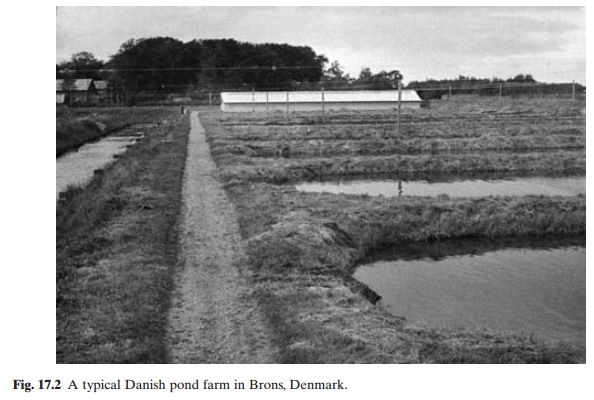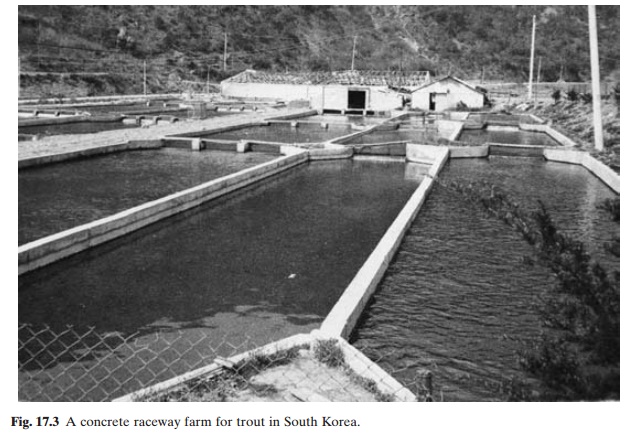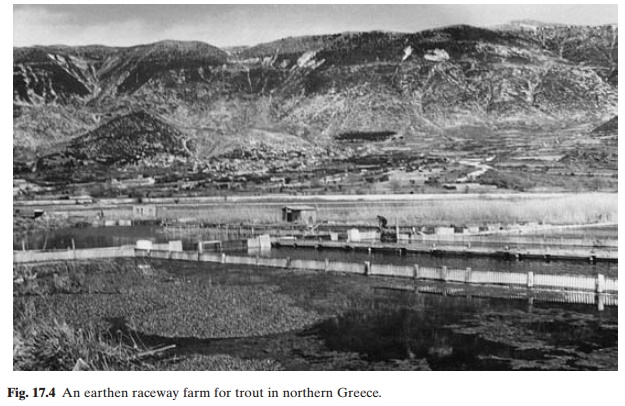Chapter: Aquaculture Principles and Practices: Trouts and Salmons
Culture systems of Trouts
Culture systems
As mentioned earlier, the original system of trout culture consisted of
hatchery propagation and rearing of young for stocking streams, lakes and other
water bodies. This system will be discussed further. The techniques of brood
stock development, stripping, fertilization, incubation of eggs and larval
rearing are very similar for rainbow and brown trouts.
Although the natural methods of spawning, fertilization and incubation
of eggs in redds (depressions or nests) on the stream bed are used for some
salmons, they are hardly used in the propagation of trouts.
Commercial trout farming in ponds originated in Denmark some 45 years
ago.The farms consist of earth ponds excavated on more or less level ground,
with water from a nearby river or other suitable water source, ideally supplied
by gravity.When energy is not very expensive, water may be supplied by pumping.
Fig. 17.2 shows the typical layout of a Danish trout farm. The general
principles followed are the same as described for pond farms. The ponds are
rectangular in shape, usually about 30m x 10m, with the bottom sloping towards
the outlet and a depth of approximately 1m at the upper end and 1.7m at the
lower end. The capacity of such a pond is about 1500kg rainbow trout.
Land-based pond farms, supplied with pumped sea water and tidal enclosures, are
also used on a limited scale for trout culture.

Trout (rainbow, brook and brown trout) are grown in farm and ranch ponds
in many parts of the USA. The ponds are meant mainly for recreational fishing
and to provide an additional crop of highly relished food to the farmer and his
workers. The farmer purchases fry or fingerlings from hatcheries in the spring
and harvests them before the winter freeze-up. If the farmer is able to
overwinter the stock, he grows at least a part of his stock for a second year,
when he can expect reasonably large fish for angling. The best results are
obtained with rainbow trout.
Probably the most widely used system of trout culture is in raceways,
originally used in North America, for rearing trout for restocking sport
waters. As described, race-ways consist of long continuous channels or a series
of channels divided by cross-walls. They are generally constructed of earth,
brick or cement concrete, sunk in the ground or built above ground level (fig.
17.3). The channels are narrow, with a width of 2–4m and a depth of less than 1m.
The most important requirement of raceway culture is a plentiful supply of
clean water, flowing through the channels. Most raceway farms depend on spring
water with a constant temperature and flow velocity (fig. 17.4). Stocking
density depends on water temperature, but is around 4–5kg/m3 when there is a water exchange
of 2.5l/min per m3.


Another system in use, especially in Europe including the UK, is tank culture. Typical trout tanks are 4–10m in diameter and 1.6m deep (see fig. 6.17). Tanks are
generally sunk in the ground, leaving about 30cm above ground. The drainpipes
are laid in trenches and connected to prefabricated outlet sumps. Many new
trout tank farms have a central fish grading arrangement. Each tank has a
separate outlet pipe connected to a separate main, leading to a sump where the
fish can be graded. The fish, along with the water, are pumped out through the
grading sump.
Cage farming of trout is a rapidly expanding system and is increasingly
being used in both fresh- and salt-water environments. Though presently
restricted in its use to sheltered areas of the sea and inland impoundments
(fig. 17.5; see also figs. 6.25 and 6.26), considerable development is taking
place in the design and construction of cage farm units which can be operated
in more exposed areas and can withstand rough weather conditions. Thus
unforeseen opportunities for extending cageculture systems of trout and other
salmonids are opening up. As mentioned, there are several designs of cages
presently in use.A trout culturist may produce only eyed ova for shipment and
sale to producers elsewhere, or may hatch them and rear the hatchlings to fry
or fingerling stages for restocking. Many rear them to market size for sale to
consumers either fresh or after processing.

A system of trout production somewhat similar to restocking is what is
often called put-and-take fishing, or put-and-take stocking for the benefit of
sport fishermen. This has been in practice in North America for a long time,
and is becoming common in Western Europe. Trout are raised to market size and
then stocked in sport waters, where anglers are allowed to fish for a fee. The
producer can combine production for the market with sale for stocking, and can
also combine trout farming with a put-and-take fishery of his own. The main
difference from normal restocking is the need to grow the trout to an adult
size preferred by anglers. Rainbow trout are considered to be an excellent fish
to use, as they grow rapidly and have high sporting potential.
Monoculture is the most common practice in trout culture, and intensive systems are considered necessary in most situations to make the operation economically attractive. However, in areas where climatic
conditions are conducive, double-cropping systems have been introduced (Brown et al., 1974; Brown, 1979). The channel
catfish (Ictalurus punctatus) is
grown in ponds or raceways for seven months from April to October, and the
trout from the middle of November to March. The ponds are thus under production
throughout the year, instead of for only part of the year as necessitated by temperature
conditions. This is reported to bring down the cost of production and to
increase return on investments. The practice of stocking trout in carp ponds to
feed on the hatchlings and carp fry produced by wild spawning in some East
European countries is a form of polyculture. They are stocked at the rate of
10–15 per cent of the carp stock and harvested during the second year,
producing about 20– 50kg/ha of marketable trout.
Related Topics